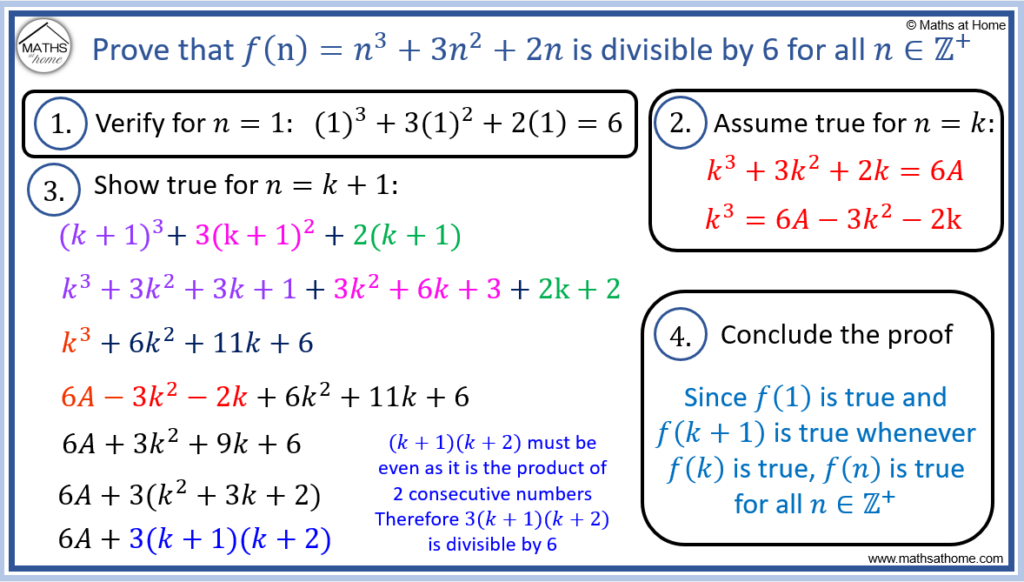Video Lesson: Proof by Induction for Divisibility
How to Prove Divisibility using Proof by Induction
To prove divisibility by induction, follow these steps:
- Show that the base case (where n=1) is divisible by the given value.
- Assume that the case of n=k is divisible by the given value.
- Use this assumption to prove that the case where n=k+1 is divisible by the given value.
- Conclude that by induction, the divisibility is true for all values of n.
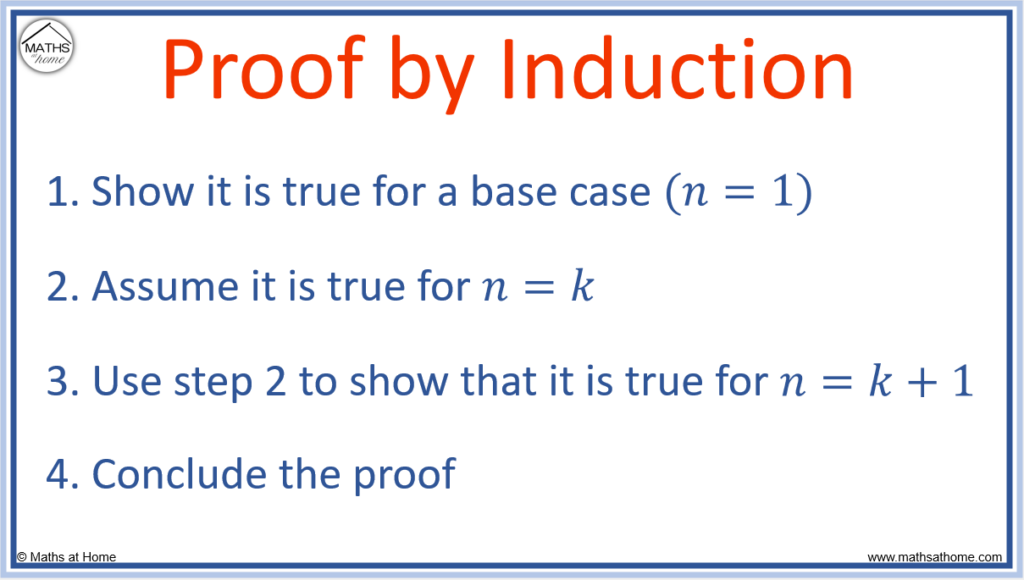
We will now look at these four steps in more detail with a few examples of proof by induction.
Example 1: Prove that is divisible by 2 for all
.
The statement of means that only positive integer values of n will be considered in this proof.
Step 1. Show that the base case (where n=1) is divisible by the given value
For the set of positive integers, the first positive integer is 1.
Therefore the base case is when n = 1.
We substitute n = 1 into n2 + n to obtain 12 + 1 = 2.
This result of 2 is divisible by 2 and therefore the base case is divisible by 2.
Step 2. Assume that the case of n=k is divisible by the given value
The result when n = k is assumed to be divisible by 2.
That is, when we substitute n = k into the expression, it is assumed that the result is divisible by 2.
Substituting n = k, we obtain k2 + k and we set this equal to 2A to show that it it divisible by 2. This is because any value that is divisible by 2 is equal to 2 multiplied by some other number. We can write this as 2A.
Therefore we write k2 + k = 2A.
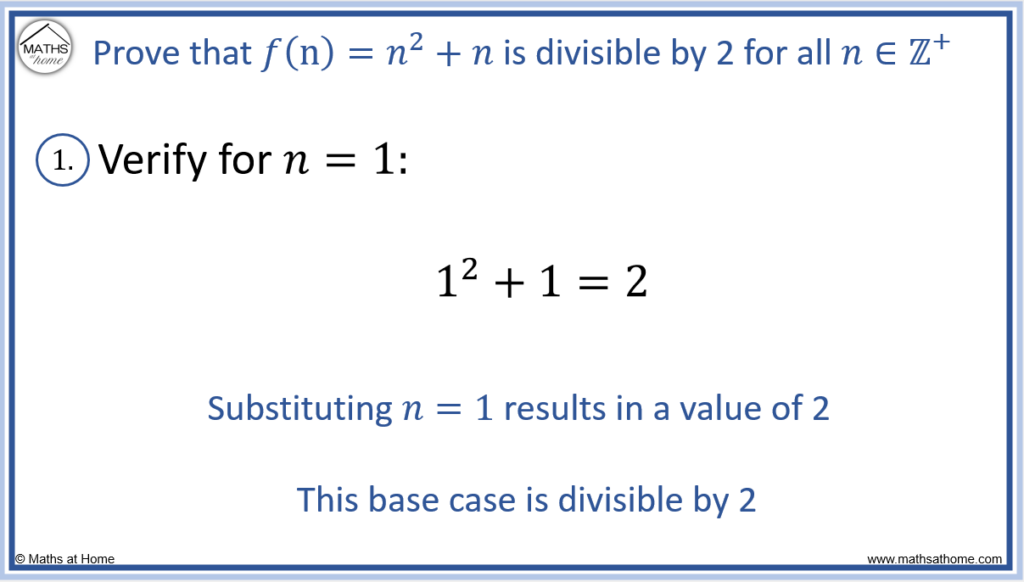

Step 3. Use this assumption to prove that the case where n=k+1 is divisible by the given value
This is the inductive step in which most of the algebra is conducted.
The goal is to substitute n = k+1 and show that the result can be simplified to an expression that is divisible by 2.
Substituting into
, we obtain
.
Expanding this, we obtain .
Simplifying, this becomes . However, it is not clear that this is divisible by 2.
Now this is fully simplified, we need to use the assumption from step 2 to assist with proving that it is divisible by 2.
In step 2 we found that . Therefore we can substitute
with
.
We split the 3k term into k + 2k and this creates .
We can then replace with 2A to obtain
.
A factor of 2 can now be taken out of all terms to obtain .
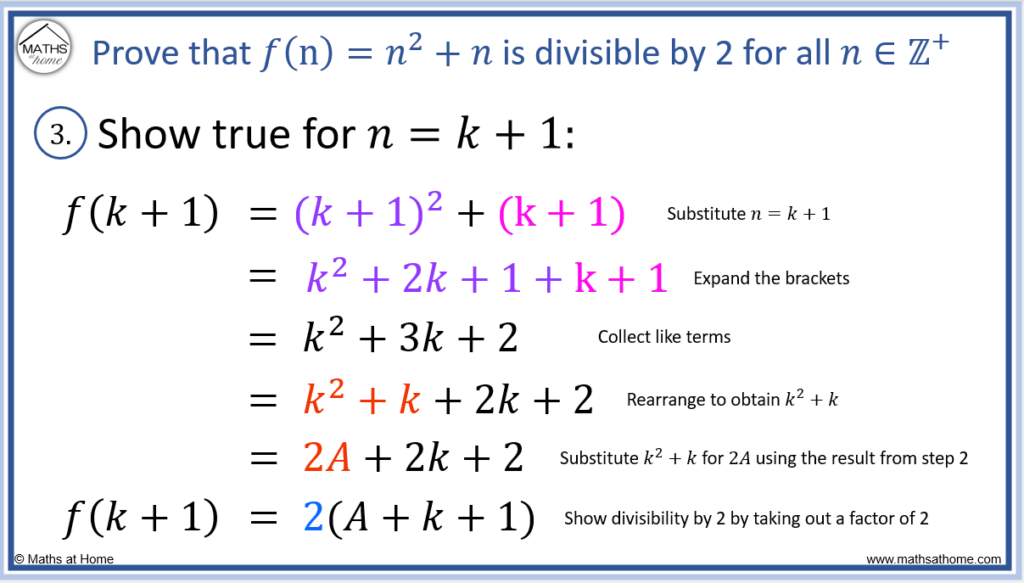
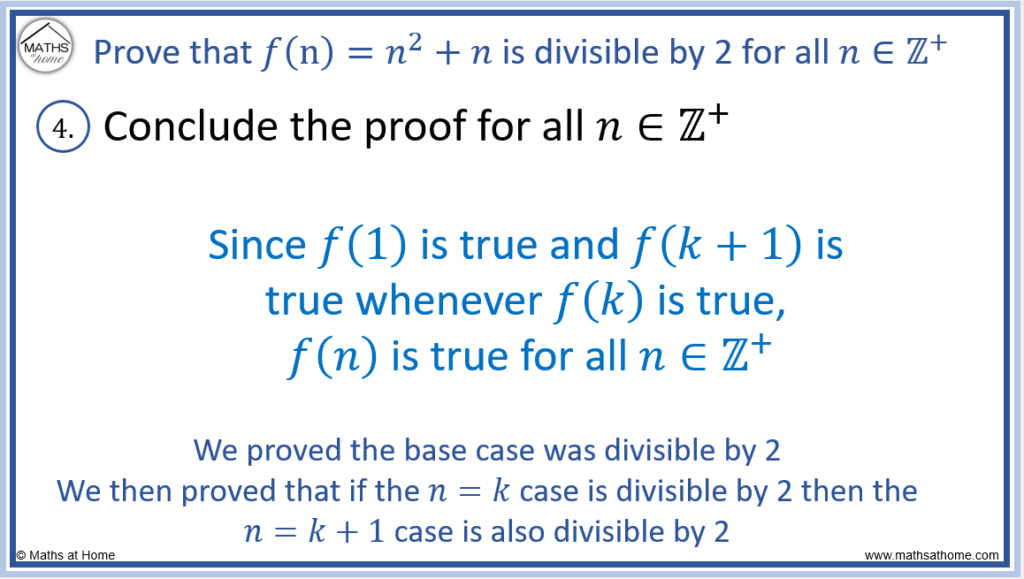
Step 4. Conclude that by induction, the divisibility is true for all values of n
When n=k+1 is substituted, the result can be written as .
Therefore it can be concluded that the result for n=k+1 is divisible by 2 provided that the result for n=k is divisible by 2.
This means that if one particular value of n is divisible by 2, then the following value of n will also be divisible by 2.
Since we showed the base case of n=1 gave us a result that was divisible by 2, all following values of n must therefore give us a result that is divisible by 2.
We can state that since is true (divisible by 2) and
is true whenever
is true.
is true for all
.
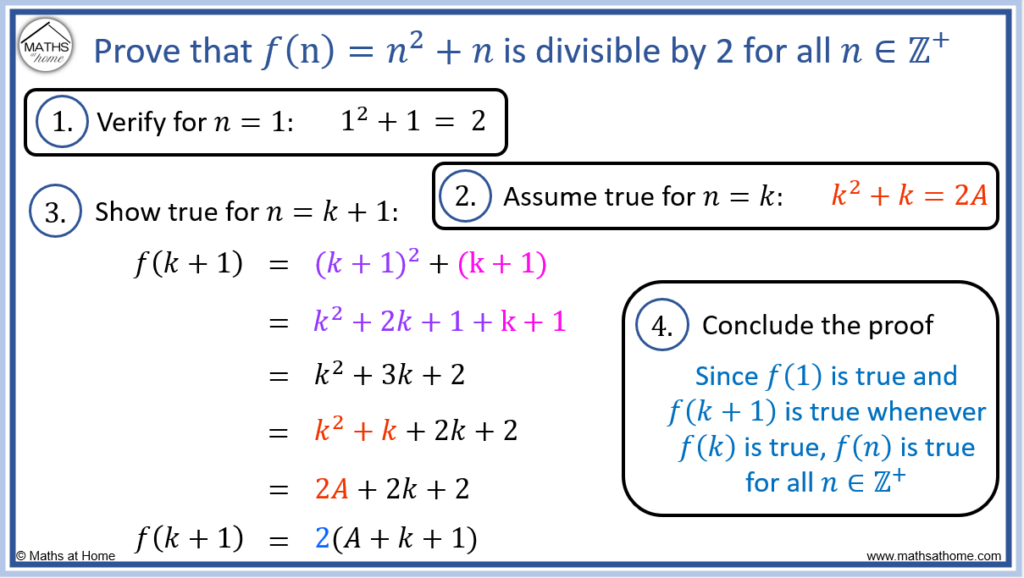
Examples of Proof by Induction for Divisibility
Here are some further examples of using proof by induction to prove divisibility.
Proof by Induction Example: Divisibility by 3
Here is an example of using proof by induction to show divisibility by 3.
Prove that is divisible by 3 for all
.
Step 1. Show that the base case (where n=1) is divisible by the given value
The base case is when n=1.
Substituting n=1 into gives a result of
which equals 0.
0 is divisible by 3 since .
Therefore the base case of n=1 provides a result that is divisible by 3.
Step 2. Assume that the case of n=k is divisible by the given value
We substitute n=k into to obtain
.
We set this equal to 3A to show that it is assumed to be divisible by 3.
We write .
We can rearrange this for k3 to obtain .
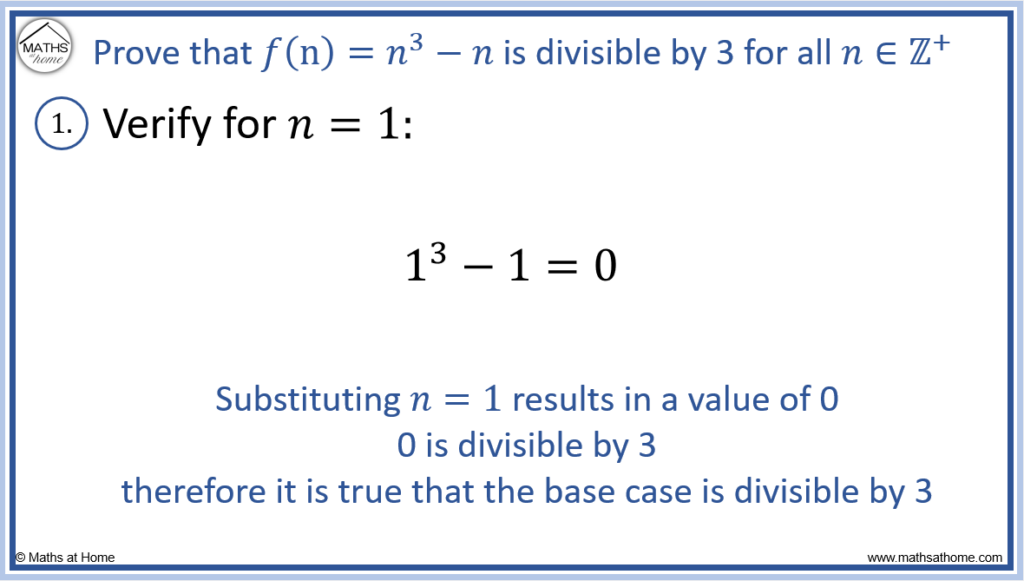
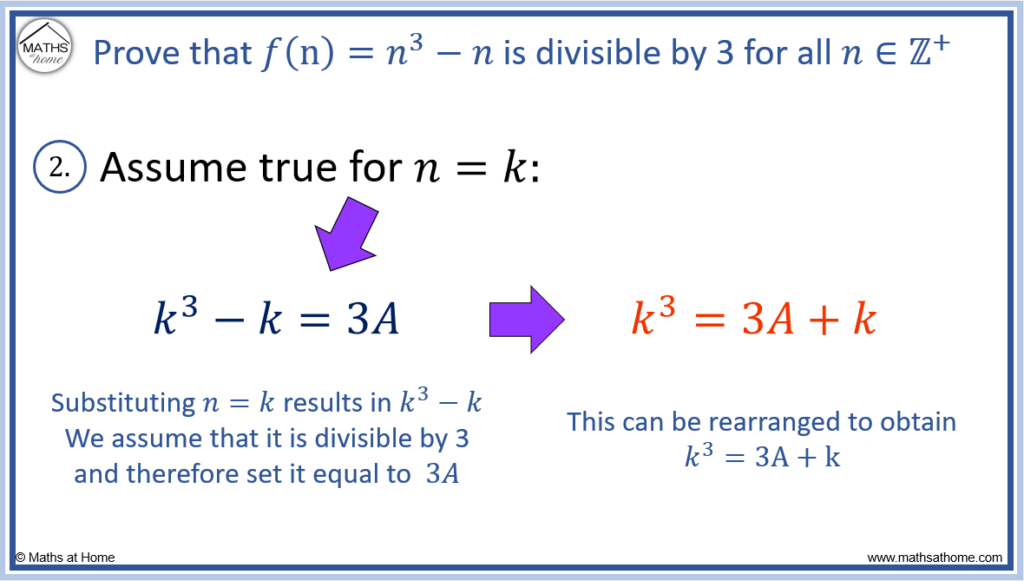
Step 3. Use this assumption to prove that the case where n=k+1 is divisible by the given value
Substituting into
, we obtain
.
Expanding, this becomes .
Collecting like terms, we obtain . It is not obvious that this is divisible by 3.
Therefore we substitute the result from step 2, .
Substituting with
, we obtain
.
Simplifying this, we obtain and a factor of 3 can now be taken out as
.
Therefore the result is divisible by 3.
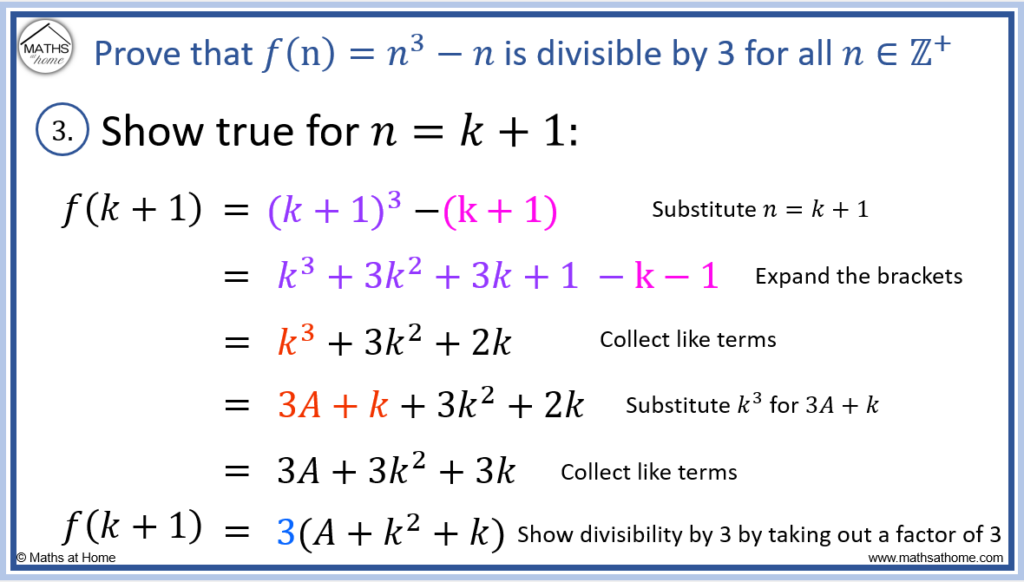
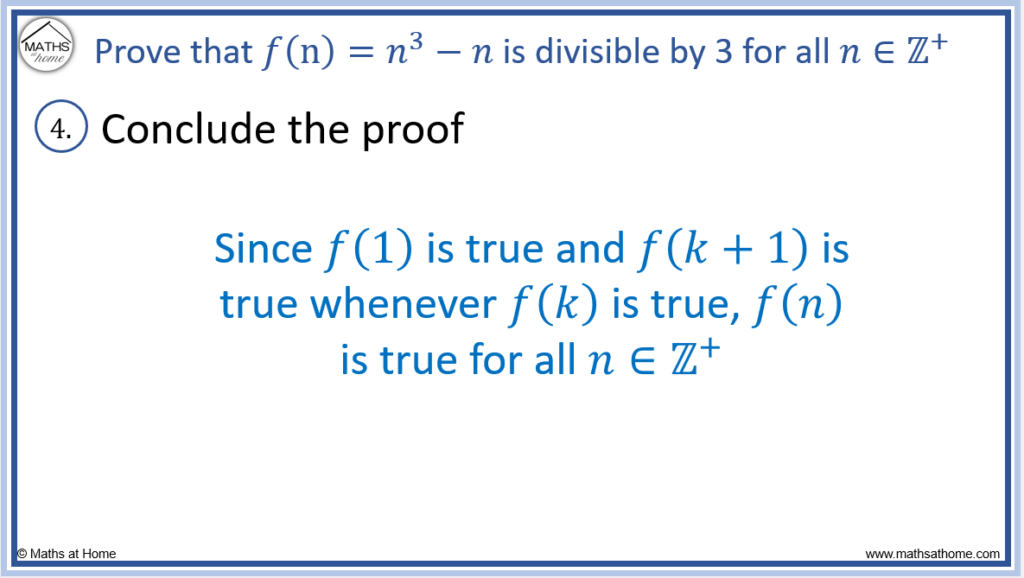
Step 4. Conclude that by induction, the divisibility is true for all values of n
Since the base case of n=1 was divisible by 3 and the n=k+1 case is divisible by 3 provided that the n=k case is divisible by 3, the proof is complete.
We state that since is true (divisible by 3) and that
is true whenever
is true,
is true for all
.
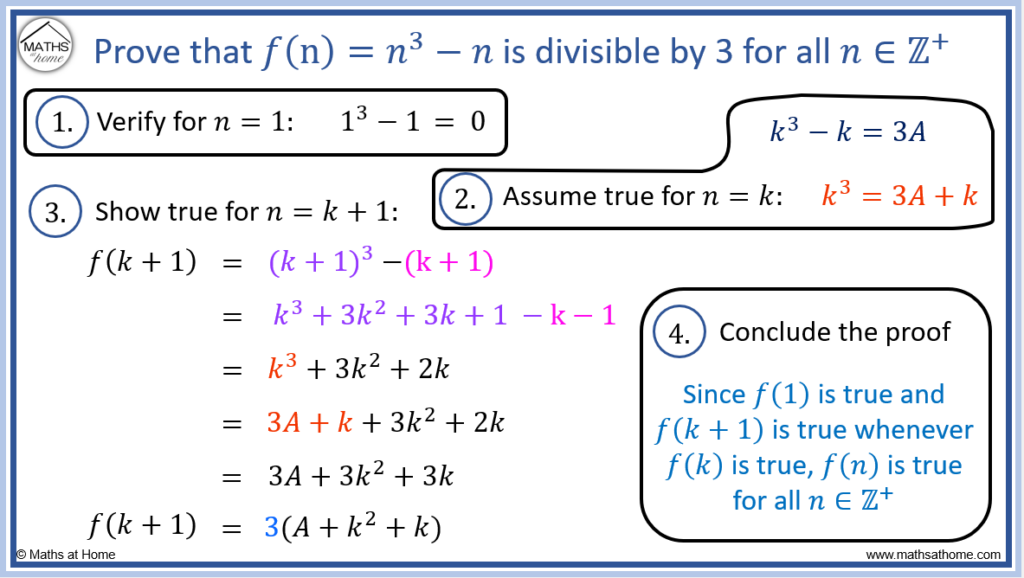
Proof by Induction Example: Divisibility by 4
Here is an example of using proof by induction to prove divisibility by 4.
Prove that is divisible by 4 for all
Step 1. Show that the base case (where n=1) is divisible by the given value
Substituting n=1, becomes
, which equals 8.
8 is divisible by 4 since .
The base case is divisible by 4.
Step 2. Assume that the case of n=k is divisible by the given value
Substituting n=k into , we obtain
.
We set this equal to 4A as we assume that it is divisible by 4.
We write .
We can rearrange this as .
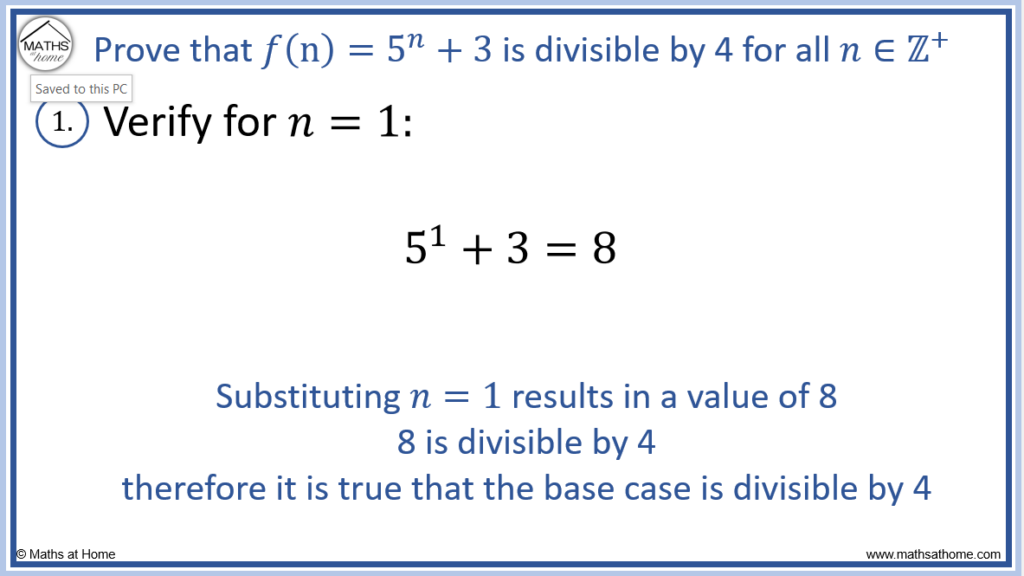
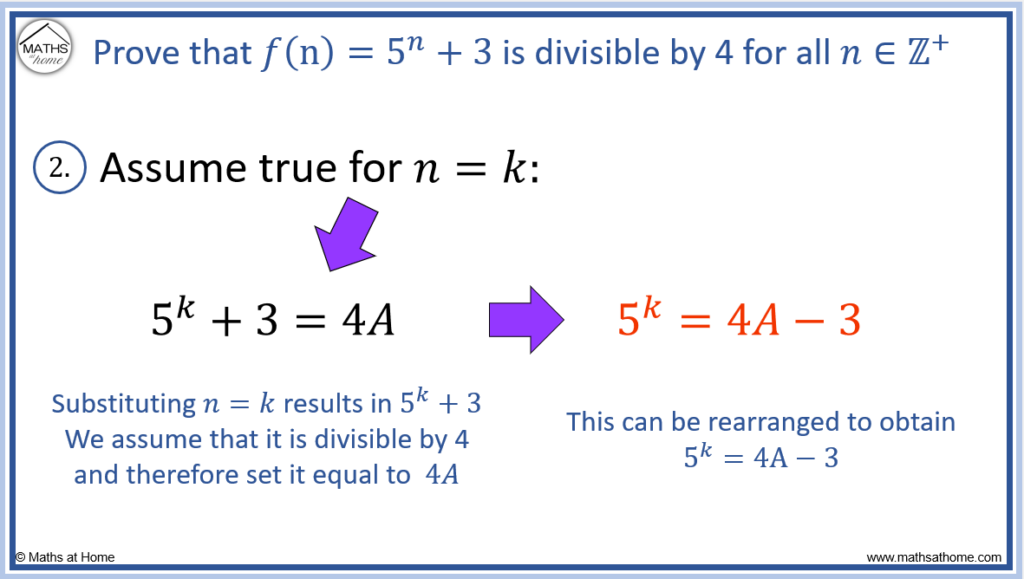
Step 3. Use this assumption to prove that the case where n=k+1 is divisible by the given value
We substitute into
to obtain
.
We can rewrite as
so that
becomes
.
In step 2, we found that and we can substitute this into the above expression to obtain
.
Expanding the brackets this becomes which simplifies to
.
We can show that this is divisible by 4 by taking out a factor of 4 as writing the expression as .
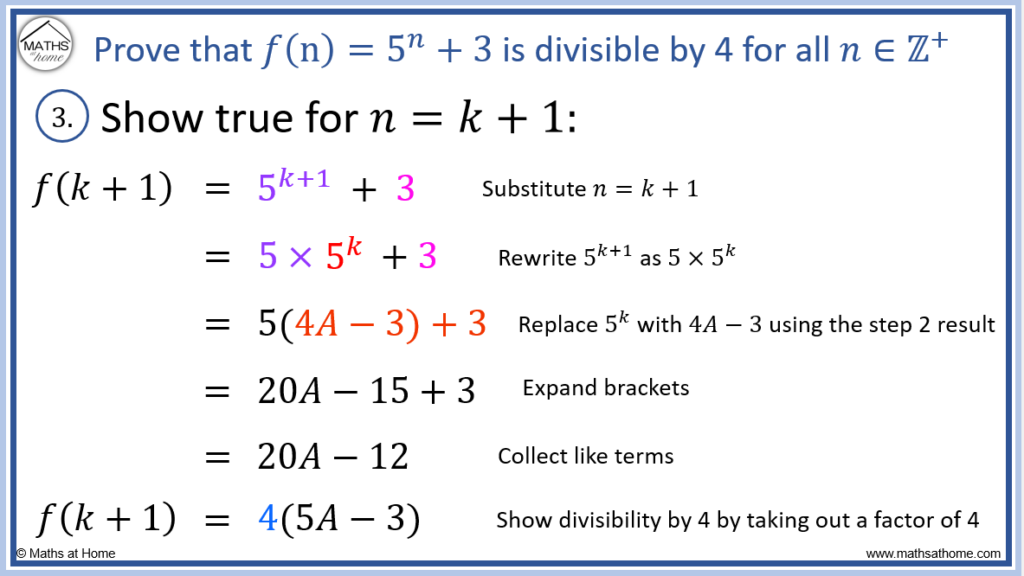
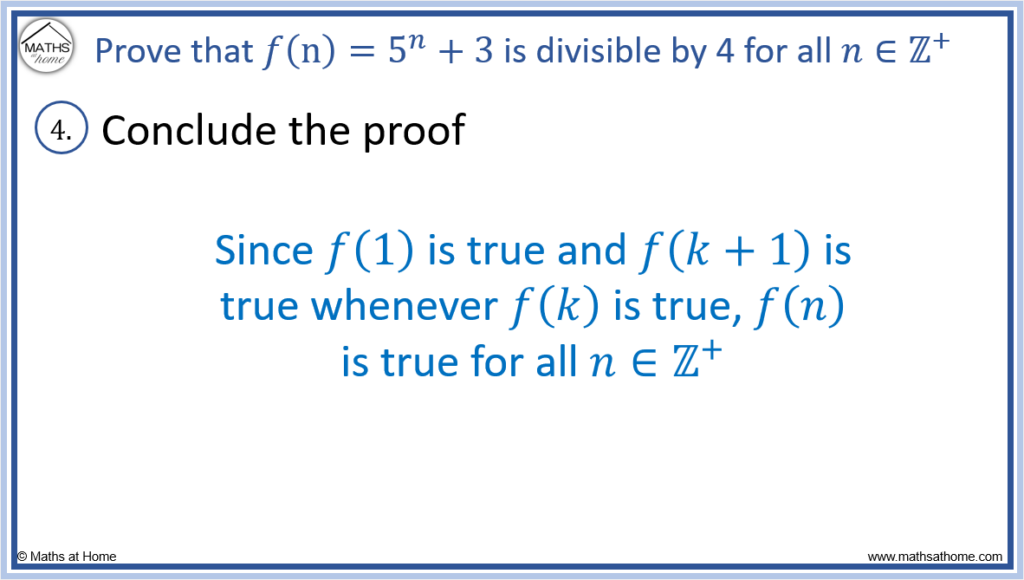
Step 4. Conclude that by induction, the divisibility is true for all values of n
Since the base case of n=1 is true and is true providing
is true,
must be true for all
.
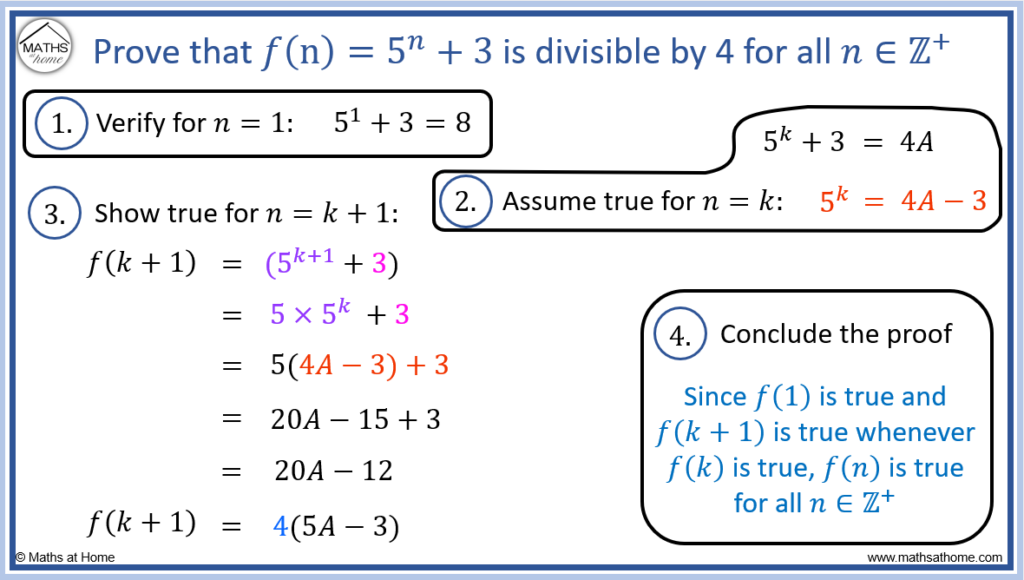
Proof by Induction Example: Divisibility by 5
Here is an example of using proof by induction to prove divisibility by 5.
Prove that is divisible by 5 for all
.
Step 1. Show that the base case (where n=1) is divisible by the given value
Substituting n=1 into , we obtain
. This result is divisible by 5 and so, the base case where n=1 is divisible by 5.
Step 2. Assume that the case of n=k is divisible by the given value
We assume that the case of n=k is divisible by 5.
Substituting n=k into , we obtain
.
We assume this is divisible by 5 and so, we set it equal to 5A to obtain
We can rearrange this as .
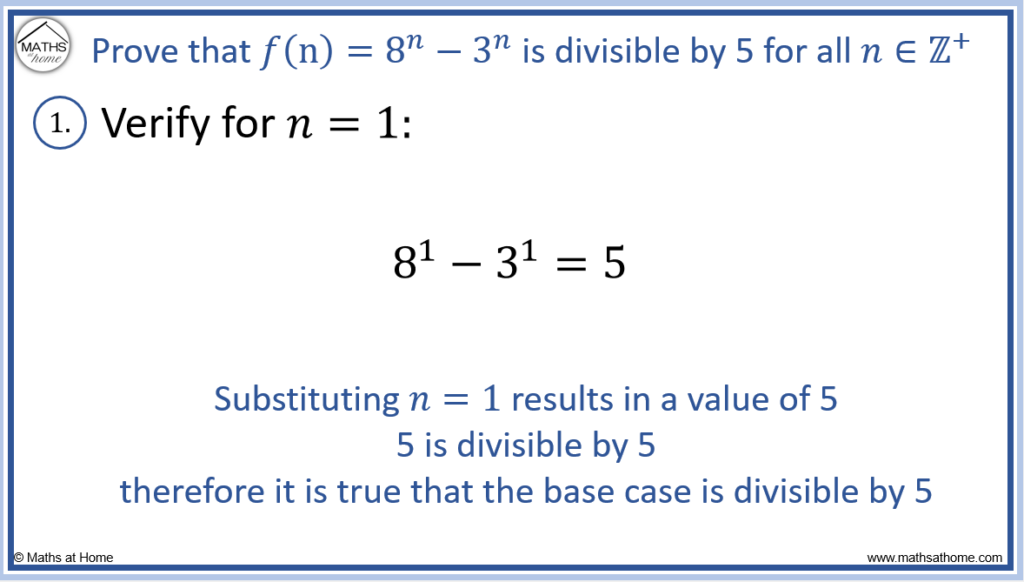
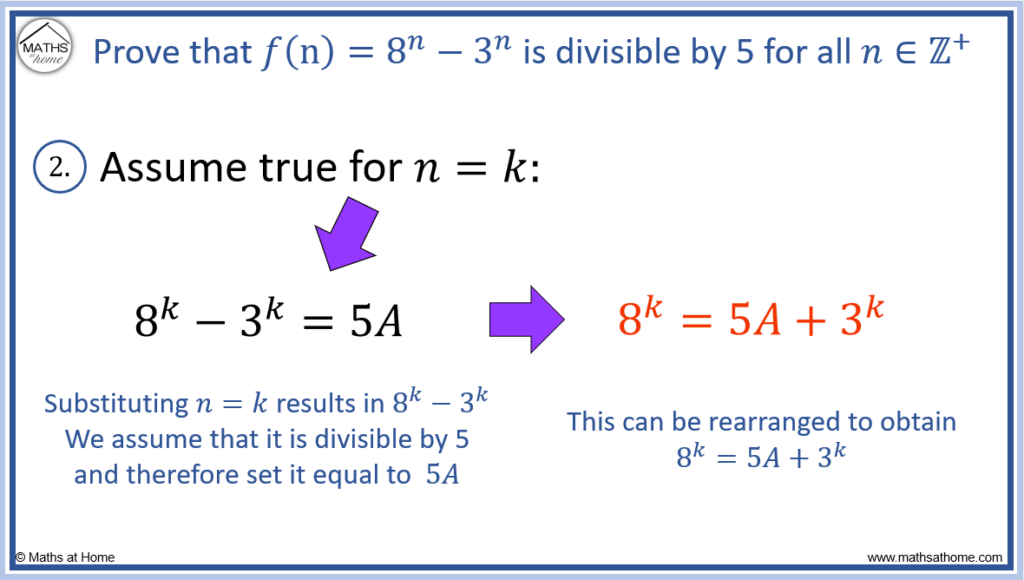
Step 3. Use this assumption to prove that the case where n=k+1 is divisible by the given value
Substituting n=k+1 into , we obtain
.
This can be written as .
In step 2, we found that .
Therefore can be written as
.
Expanding this, we obtain which simplifies to
.
Now a factor of 5 can be taken out as to show that it is divisible by 5.
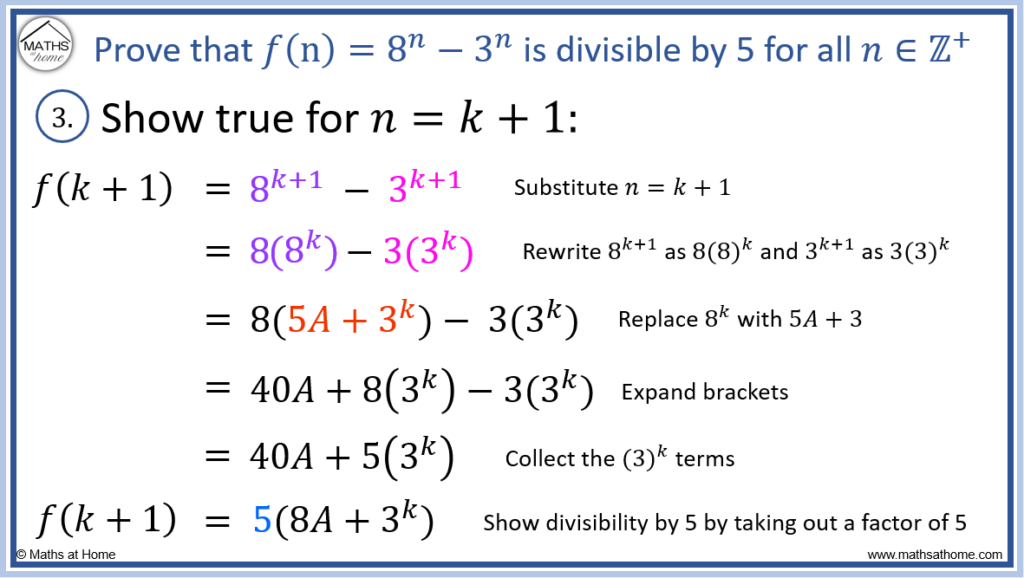
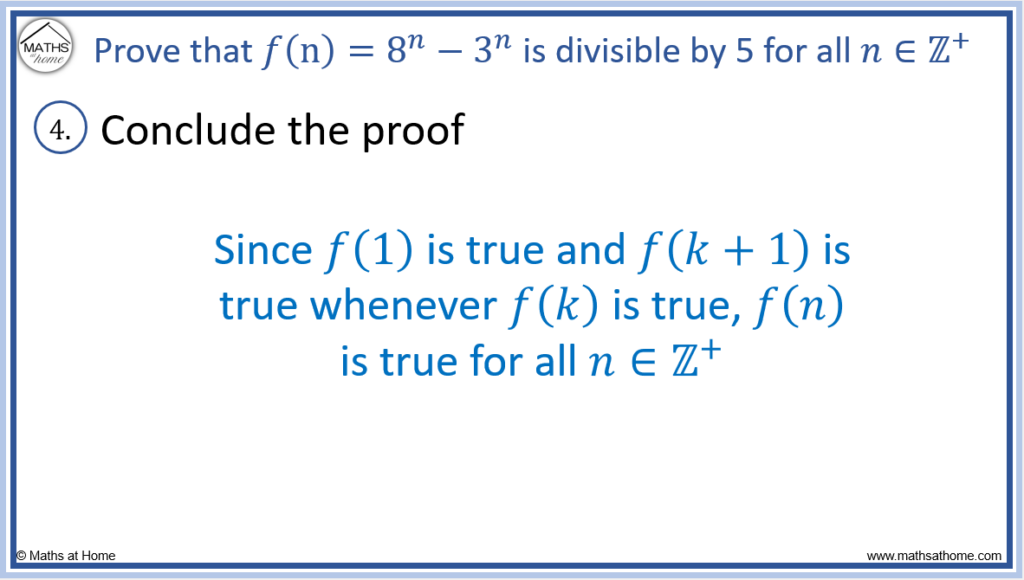
Step 4. Conclude that by induction, the divisibility is true for all values of n
Since the base case of n=1 is true and is true providing
is true,
must be true for all
.
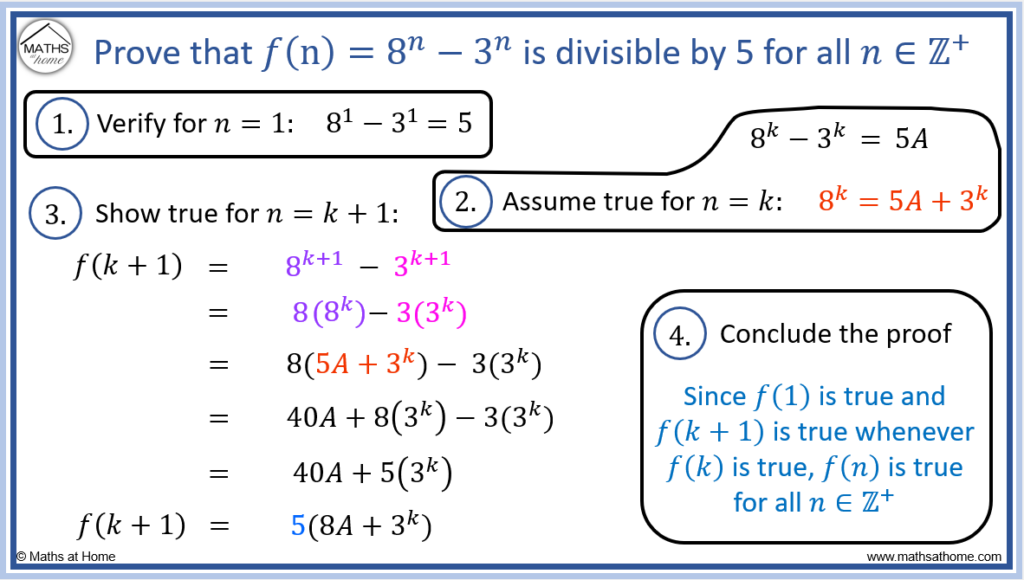
Proof of Divisibility by 6
Prove that is divisible by 6 for all
.
Step 1.
For the base case of n=1, we obtain which is divisible by 6.
Step 2.
Substituting n=k and assuming the result is divisible by 6, we obtain .
We can rearrange this as .
Step 3.
Substituting n=k+1, we obtain .
Expanding this, we obtain .
This simplifies as .
We can use the result from step 2 that to substitute for k3 above.
This becomes which simplifies to
.
This is not obvious that it is divisible by 6. We can factorise the last few terms to show this as .
This quadratic can then factorise as .
Now will always be the product of two consecutive numbers and therefore must be even. This is because one of the numbers must be a multiple of 2.
Therefore is divisible by 6 because it is 3 multiplied by a multiple of 2.
